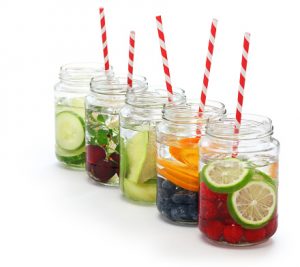 Bottles that allow you to infuse water with fruit and vegetables are all the rage right now, and while nutritionists say there is nothing wrong with that, they do want consumers to understand the real value in drinking, paying for and creating your own infusion type drinks.
Bottles that allow you to infuse water with fruit and vegetables are all the rage right now, and while nutritionists say there is nothing wrong with that, they do want consumers to understand the real value in drinking, paying for and creating your own infusion type drinks.
Infusion enthusiasts in the United Kingdom were recently introduced to a new twist on flavored water. A market called Whole Foods put three stalks of asparagus in large bottles of water and priced them at six dollars each. Store management quickly admitted it was a mistake and the asparagus water sparked new debate over the question: Are flavored waters really any better than regular water?
Nutritionists weigh in on infusion
Advertisement
Few will deny that adding fruit and vegetables to water can improve the flavor. If you drink a lot of water, after a while it can get boring so an infusion of some fresh strawberries or cucumbers can be a refreshing change. Many nutritionists say that infusing water with fruit or vegetables does have some slight benefits. They emphasize that not all fruits and vegetables are alike; some are better than others when it comes to adding value to your drink.
Asparagus has a minimal impact when added to water. To get any real nutritional value the experts estimate you would have to add half a cup of asparagus to your water, as opposed to the three pieces that Whole Foods used. Eating asparagus on the other hand is a great idea since it is a source of vitamins K, C, E and dietary fiber.
The general opinion among nutritionists in North America is that strawberries and citrus fruits are the best options when it comes to infusing because when squeezed, they release vitamins into the water. The other important point to keep in mind is that it is better to consume water that is flavored with fresh fruit and vegetables than water flavored through other means. The water with the real fruit and vegetables will have more nutrients in it. As for paying five or six dollars for water that is infused with something like three stalks of asparagus – well, most nutritionists call that senseless.
The best fruits and vegetables for water infusion
Drinking water every day is important. Keeping hydrated can have a major impact on your overall health. If you get tired of plain water and want to infuse your drinks, here are the best fruits and vegetables to use:
- Grapefruit – rich in phytonutrients, vitamin A and C
- Grapes – contain antioxidants, including flavonoids and resveratrol
- Lemons – low in calories and good for our immune system
- Strawberries – rich in vitamin C, antioxidants and add sweetness
- Raspberries – full of fiber and vitamins
- Cucumbers – contain B vitamins and anti-cancer components
- Limes – aid in digestion and contain antioxidants
- Oranges – rich in vitamin C and sweet
- Carrots – rich in vitamin K, C, E, and potassium
Preparing veggies and how it impacts nutrients
Soaking fruits and vegetables correctly:
Many plants are in close contact with common microbes in dirt, so soaking vegetables in water before cooking or eating them raw is a routine most of us practice. However, over-soaking vegetables causes nutrients to leach out. While this is exactly the result you want when you are infusing water with fruit and vegetables, it is not the case if you are preparing a meal.
Nutritional scientists say that vitamin C tends to leach out much easier than other vitamins, minerals and phytochemicals. Keep in mind that chopping vegetables into small pieces and then soaking them is a bad idea because more area is exposed to water, as well as air, thus oxidizing some of the nutrients. It is best to leave the vegetables and fruit intact when washing or soaking.
Water isn’t the only option when it comes to sanitizing. Soaking vegetables in diluted white vinegar (one part vinegar to three parts water) can be more effective. Some researchers report that this method kills 98 percent of the bacteria, while tap water and scrubbing with a brush eliminates around 85 percent.
Cooking your vegetables for infusion
Advertisement
When it comes time to cook vegetables, we have to consider just how we are going about it. After all, we want to maximize the nutritional benefits. Cooking alters the nutrient value of vegetables and fruit. Some methods destroy nutrients and others can enhance nutrients.
Just like too much soaking can negatively impact vitamin C, if you over-boil vegetables with a lot of vitamin C in them, the nutrients will leach out of them and into the cooking water. Kale, spinach and broccoli also tend to lose a lot of nutrient value during cooking. Nutrients including vitamins A, E and K are more stable during cooking. Dry cooking methods, such as grilling and roasting, retain a larger amount of nutrients than boiling. If you are someone who prefers to boil, save the nutrient-rich cooking water and add it to soups and sauces to get the benefits.
There is a rainbow of fruit and vegetables to choose from, so make a list of your favorites including some that you have never tried before, and when your daily water intake starts to become a bore – try giving it a healthy jolt with something on that list.
